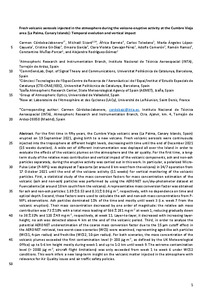Por favor, use este identificador para citar o enlazar este ítem:
http://hdl.handle.net/20.500.11765/14398
Fresh volcanic aerosols injected in the atmosphere during the volcano eruptive activity at the Cumbre Vieja area (La Palma, Canary Islands): temporal evolution and vertical impact
| Título : | Fresh volcanic aerosols injected in the atmosphere during the volcano eruptive activity at the Cumbre Vieja area (La Palma, Canary Islands): temporal evolution and vertical impact |
| Autor : | Córdoba-Jabonero, Carmen; Sicard, Michaël; Barreto Velasco, África






|
| Palabras clave : | Mass conversion factors; Polarized Micro-Pulse Lidar; Remote sensing; Cumbre Vieja volcano; Sun/sky photometer; Volcanic ash |
| Fecha de publicación : | 2023 |
| Editor: | Elsevier |
| Citación : | Atmospheric Environment. 2023, 300, 119667 |
| Versión del editor: | https://doi.org/10.1016/j.atmosenv.2023.119667 |
| Resumen : | For the first time in fifty years, the Cumbre Vieja volcanic area (La Palma, Canary Islands, Spain) erupted on September 19, 2021, giving birth to a new volcano. Fresh volcanic aerosols were continuously injected into the troposphere at different height levels, decreasing with time until the end of December 2021 (15 weeks duration). A wide set of different instrumentation was deployed all over the Island in order to evaluate the effects of the volcanic plumes on the atmosphere and the air quality. For the first time, a long-term study of the relative mass contribution and vertical impact of the volcanic components, ash and non-ash particles separately, during the eruptive activity was carried out in this work. In particular, a polarized Micro-Pulse Lidar (P-MPL) was deployed at Tazacorte (at around 8 km west from the volcano) in 24/7 operation from October 17, 2021 until the end of the volcano activity (11 weeks) for vertical monitoring of the volcanic particles. First, a statistical study of the mass conversion factors for mass concentration estimation of the volcanic (ash and non-ash) particles was performed by using the AERONET sun/sky-photometer dataset at Fuencaliente (at around 18 km south from the volcano). A representative mass conversion factor was obtained for ash and non-ash particles: 1.89 ± 0.53 and 0.31 ± 0.06 g m−2, respectively, with no dependence on time and optical depth. Second, these factors were used to calculate the ash and non-ash mass concentrations from P-MPL observations. |
| Patrocinador: | This research was funded by the Spanish Ministry of Science and Innovation (PID2020-118793GA-I00, PID2019- 104205GB-C21/AEI/10.13039/501100011033, PID2019-103886RB-I00, EQC2018-004686-P) and the Unit of Excellence “María de Maeztu” (MDM-2017-0737) and ACTRIS-Spain (CGL2017-90884-REDT) by the Spanish 595 State Research Agency (AEI). The authors wish to thank the support from the H2020 program of the European Union and ACTRIS (GA n. 19ENV04, 654109, 778349, 871115, 101008004, and 101086690), and the European components of AERONET acting in the frame of ACTRIS RI, and also AEROSPAIN and Junta de Castilla y León (VA227P20) for supporting the calibration of the AERONET sun photometer used in this publication. |
| URI : | http://hdl.handle.net/20.500.11765/14398 |
| ISSN : | 1352-2310 |
| Colecciones: | Artículos científicos 2023-2026 |
Ficheros en este ítem:
| Fichero | Descripción | Tamaño | Formato | ||
|---|---|---|---|---|---|
| manuscript_AtmEnv2023... | 7,4 MB | Adobe PDF |  Visualizar/Abrir |
Los ítems de Arcimis están protegidos por una Licencia Creative Commons, salvo que se indique lo contrario.





